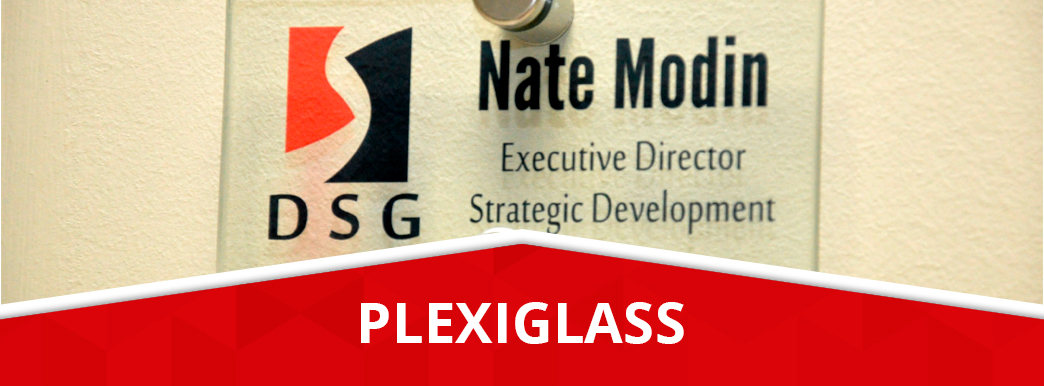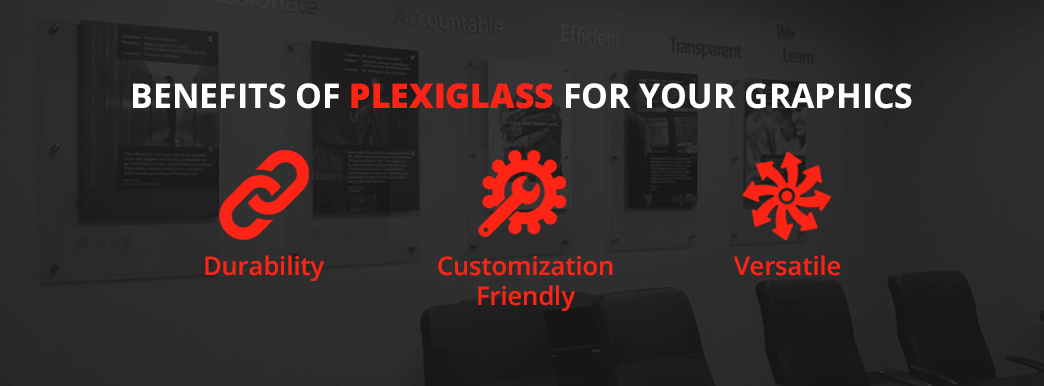As you try to determine what materials to use for your graphics and signage, you may want to consider Plexiglass. With this material, you can create several signage types and be confident that the finished product will impress potential clients or customers. Plexiglass has numerous benefits that make it a popular choice among companies who want only the best for their signage.
WHAT IS PLEXIGLASS?
Plexiglass is a brand name for a specific type of acrylic that goes through a unique manufacturing process. Plexiglass and acrylic are both versatile substrates and are a type of plastic sheets. They come from the chemical polymethyl methacrylate and have a glass-like appearance, despite being thermoplastic.
In its most basic forms, Plexiglass is colorless and transparent. When compared to glass, Plexiglass often offers greater transparency, as glass is more likely to reflect light, creating reflections and glares. Thermoplastic offers greater shatter-resistance, durability, and protection against erosion when compared to glass. Due to its higher strength and transparency, many businesses choose Plexiglass for their signs and graphics.
DIFFERENCE BETWEEN PLEXIGLASS AND ACRYLIC
Often acrylic and Plexiglass are used interchangeably to refer to sheet plastic. Despite the common usage of the two terms, there are some less than obvious distinctions that should be made between the two terms. Plexiglass refers to a specific type of acrylic, while acrylic is an overarching term for materials made out of polymethyl methacrylate.
Here are some of the key differences between the two terms:
1. MANUFACTURING
Acrylic can be manufactured using either the cell cast or the extrusion method. Extrusion is a less expensive manufacturing method and is not used in Plexiglass manufacturing. The extrusion process results in a substance that is softer and more likely to scratch than cell-cast acrylic is.
In contrast, Plexiglass, or cell cast acrylic, goes through a more expensive manufacturing process, but the final product will be much harder. This hardness means that Plexiglass has a lower chance of cracking as compared to extrusion acrylic.
2. APPEARANCE
Compared to extrusion acrylics, Plexiglass has fewer impurities, making it more transparent and visually appealing. Due to how extruded acrylic is manufactured, specks and tiny ripples on the surface of the acrylic can form. To prevent this, Plexiglass is created in an enclosed area, which reduces the chances of contaminants coming in from the outside area and sticking to the material. As Plexiglass has a more controlled manufacturing process than extrusion acrylic, it is the more visually appealing of the two. With cell casting, you can be sure that you’re getting something with significantly fewer impurities in it.
3. COST
Due to Plexiglass’s high quality, it usually costs more than extrusion acrylic. While extrusion acrylic can be better if you’re looking to glue together multiple sheets of acrylic, it’s often worth the extra cost for Plexiglass. The purer appearance and hardness of Plexiglass make it a go-to for companies looking to present themselves as a business devoted to quality.
THE BOTTOM LINE
So, while all Plexiglass is acrylic, not all acrylic is Plexiglass. If you’re looking for acrylic that’s tough and blemish-free, ask for Plexiglass. Knowing the difference between the standard, extrusion acrylic and cell cast acrylic will help you as you determine what kind of signage and graphics you need for your company. When discussing acrylic signage with a printing company, you’ll want them to ask whether they are talking about Plexiglass or extrusion acrylic.
BENEFITS OF PLEXIGLASS FOR YOUR GRAPHICS
To be more confident in your choice of Plexiglass, consider some of its benefits:
1. DURABILITY
Plexiglass is a lightweight material that maintains its strength even when exposed to the elements. Even though it’s a light material, its durability is unmatched. As it’s so tough, you can feel confident that you won’t cause any accidental damage while transporting and installing it.
Plexiglass is more durable than wood, glass, and metal in addition to extrusion acrylic. If you’re looking to purchase exterior signage that doesn’t need constant repairs and replacements, then Plexiglass is the material for you. Plexiglass signage will hold up against the elements and other environmental pressures longer than most materials, making it an ideal choice for those who care about quality.
2. CUSTOMIZATION FRIENDLY
There are several uses for acrylics, making them incredibly customizable and attractive to companies who like to have variety in their signage. For example, Plexiglass is easily cut into whatever shapes or sizes you need for your graphics to be most effective. For especially creative Plexiglass signage, the material can even be multi-layered, giving greater depth and texture to your graphics.
3. VERSATILE
Plexiglass is a material that you can trust to bring out the best qualities of a variety of colors and images. With detailed etching, varied dimensions, and a transparent background, Plexiglass is an excellent host for your advertisements and branded messages. If you’d like to employ custom lighting, Plexiglass does exceptionally well with spotlighting and backlighting.
EXAMPLES OF PRODUCTS WITH PLEXIGLASS
Plexiglass is commonly used in a wide variety of products. Below are some of the main forms that the material takes:
- Plexiglass signage: Coming in a variety of shapes and sizes, Plexiglass is an excellent base for a variety of signs. Graphics can easily be included on the surface, highlighting their best qualities.
- Frosted Plexiglass: Though Plexiglass is a clear material, if you want greater privacy, Plexiglass can be frosted, so there is not a clear line of sight through it. This feature is perfect for those who want to let natural light into cubicles or private office spaces but who still want employees to have a sense of privacy.
- Dimensional lettering: If you really want to make your lettering pop, Plexiglass offers the durability and customizability needed for dimensional lettering.
- Other products: Plexiglass can also be used for logos, maps, photo prints, and much more.


